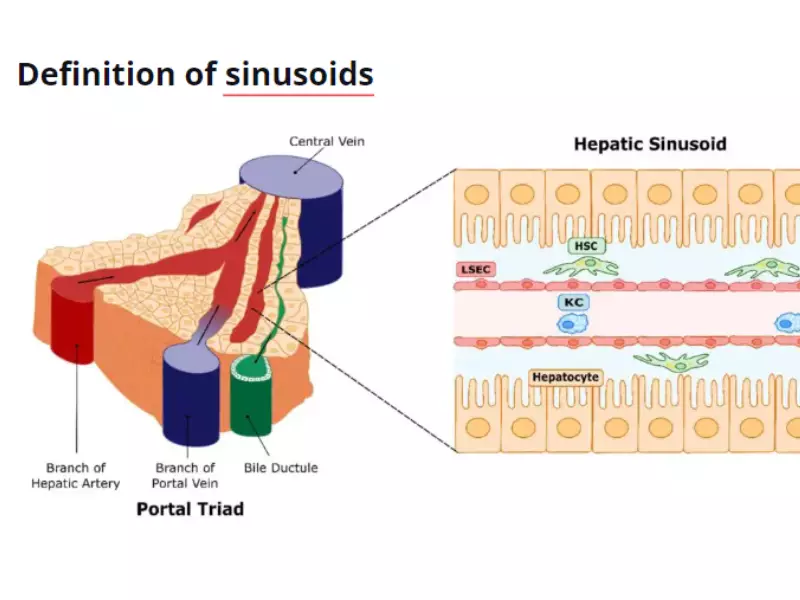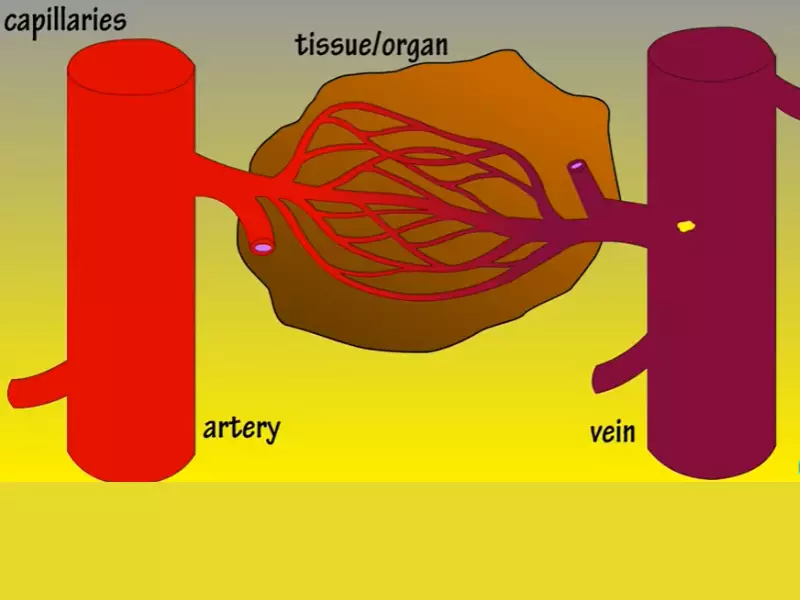The human circulatory system, a complex network of blood vessels, serves as the lifeline of the body, transporting essential nutrients, gases, and waste products to and from cells. Among its myriad components, sinusoids and capillaries play crucial but distinctly different roles in this system. These vessels, while both integral to bodily functions, differ significantly in structure, location, and function, reflecting their specialized roles within the body.
Sinusoids are specialized vessels that are larger than capillaries, characterized by their irregularly shaped, open-ended lumen and highly permeable walls. They are primarily found in the liver, spleen, and bone marrow, where they facilitate the transfer of various substances between the blood and surrounding tissues. Capillaries, on the other hand, are the smallest blood vessels in the body, with a simple structure that allows for the efficient exchange of gases, nutrients, and waste products between the blood and the body’s cells.
These vessels’ structural differences mirror their distinct functional roles: sinusoids support the filtration and processing of blood, participating in metabolic and immune system activities, while capillaries are pivotal in the systemic exchange of gases and nutrients. Understanding these differences is essential for comprehending how the body maintains its internal environment and responds to physiological and pathological changes.

Basic Concepts
Blood Vessels: Role in the Body
Blood vessels form an intricate network that is vital for transporting blood throughout the body. This system ensures that oxygen, nutrients, and waste products are efficiently exchanged between the body’s tissues and the external environment. Blood vessels are classified into three main types: arteries, veins, and capillaries. Arteries carry blood away from the heart, veins return blood to the heart, and capillaries connect arteries to veins, facilitating the exchange of substances between blood and tissues.
Sinusoids: Definition and Function
Sinusoids are a special type of blood vessel found in certain organs, including the liver, spleen, and bone marrow. Unlike other vessels, sinusoids have a larger diameter and more permeable walls, which allow for the efficient transfer of larger particles and cells between the blood and surrounding tissue. Their primary function is to filter blood, removing old or damaged cells and pathogens, while also facilitating the exchange of metabolic substances.
Capillaries: Definition and Function
Capillaries are the smallest blood vessels in the body, with diameters so small that blood cells can only pass through them in single file. Their walls are just one cell thick, allowing for the optimal exchange of gases, nutrients, and waste products between the blood and the cells of various tissues. This exchange is critical for maintaining the body’s internal environment and ensuring the proper functioning of cells.
Structural Differences
Sinusoids
Wall Structure
Sinusoid walls are less structured compared to those of other blood vessels. They lack a continuous basal lamina and often have gaps between endothelial cells, making them highly permeable.
Diameter and Permeability
The diameter of sinusoids is larger than that of capillaries, which allows for the passage of larger molecules and cells. Their high permeability facilitates the transfer of substances between the bloodstream and the interior of organs.
Capillaries
Wall Structure
The walls of capillaries are composed of a single layer of endothelial cells. This simplicity maximizes their efficiency in exchanging materials between the blood and tissues.
Diameter and Permeability
Capillaries have a small diameter, which slows down blood flow and provides more time for the exchange of gases, nutrients, and waste. Their walls are permeable to these small molecules but typically prevent larger cells from passing through.
Functional Variations
Sinusoids
Location and Significance
Sinusoids are strategically located in organs that require extensive filtration and processing of blood, such as the liver, spleen, and bone marrow. Their structure and function are crucial for the body’s defense mechanisms, metabolism, and blood formation.
Filtration and Exchange Processes
Sinusoids facilitate the filtration of blood, removing debris and pathogens, and support the exchange of large molecules and cells. This is essential for detoxification processes in the liver and the maturation of blood cells in the bone marrow.
Capillaries
Oxygen and Nutrient Exchange
Capillaries are primarily responsible for the exchange of oxygen and nutrients between the blood and tissues. This process is fundamental to the survival of cells and the proper functioning of the body’s organs.
Role in Different Tissues
The role of capillaries varies depending on the tissue type. For example, in the lungs, they are involved in gas exchange, while in the muscles, they support the delivery of nutrients and removal of waste products during physical activity.
Location and Distribution
Sinusoids
Common Locations
Sinusoids are commonly found in the liver, spleen, and bone marrow. Each of these organs relies on the unique properties of sinusoids to fulfill its specific functions.
Organ-specific Roles
In the liver, sinusoids help in filtering blood and metabolizing substances. In the spleen, they assist in removing old or damaged blood cells. In the bone marrow, sinusoids support the release of newly formed blood cells into the bloodstream.
Capillaries
Distribution in the Body
Capillaries are distributed extensively throughout the body, forming a dense network that penetrates nearly all tissues. This widespread distribution ensures that every cell is in close proximity to a capillary, facilitating efficient exchange.
Tissue-specific Functions
The functions of capillaries vary by tissue, tailored to meet the specific needs of each area. In the brain, for example, the blood-brain barrier formed by capillaries protects neural tissue from harmful substances, while in the kidneys, capillaries play a key role in the filtration of blood and the formation of urine.

Physiological Importance
Sinusoids
Detoxification and Metabolism
Sinusoids play a pivotal role in the body’s detoxification processes, particularly in the liver, one of their primary locations. These vessels allow for the efficient transfer of substances between the blood and liver cells, enabling the liver to process nutrients, neutralize toxins, and produce bile. This is crucial for metabolizing carbohydrates, fats, and proteins, transforming them into energy and other forms that are easier for the body to use or excrete.
Immune Response Facilitation
In addition to their metabolic functions, sinusoids are integral to the body’s immune response. Their unique structure, with gaps between endothelial cells, allows immune cells to pass from the blood into tissues where they can combat pathogens. This is especially evident in the spleen, where sinusoids filter blood and help identify and destroy old or damaged red blood cells and foreign invaders.
Capillaries
Gas Exchange
The primary physiological role of capillaries is facilitating gas exchange. This occurs when oxygen is delivered from the blood to tissues and carbon dioxide is transported from tissues to the blood. This exchange is vital for cellular respiration, a process by which cells produce energy.
Nutrient and Waste Transport
Beyond gas exchange, capillaries are essential for the transport of nutrients to tissues and the removal of waste products. Nutrients like glucose and amino acids pass through capillary walls to nourish cells, while waste products such as urea and carbon dioxide are carried away for excretion. This constant cycle supports the health and function of every cell in the body.
Pathological Conditions
Sinusoids
Diseases and Disorders
Sinusoidal disorders primarily affect the organs in which they are located, such as the liver and spleen. Conditions like cirrhosis and hepatic sinusoidal obstruction syndrome can severely impair liver function, leading to an inability to process toxins and produce vital proteins. Similarly, diseases affecting the spleen can disrupt the immune system and lead to increased vulnerability to infections.
Capillaries
Diseases and Disorders
Capillary function can be compromised by a range of diseases, including diabetes mellitus, which damages capillary walls and impairs blood flow, and hypertension (high blood pressure), which can cause capillaries to burst. Disruptions to capillary function can lead to tissue damage, impaired healing, and, in severe cases, organ failure.
Research and Developments
Recent Studies
Recent studies have focused on understanding the molecular mechanisms that regulate the function and formation of sinusoids and capillaries. Innovations in microscopy and molecular biology have allowed scientists to observe these vessels in unprecedented detail, leading to new insights into their roles in health and disease.
Innovations in Understanding and Treatment
One of the most exciting areas of innovation is in the development of therapies that target the unique properties of sinusoids and capillaries. For example, angiogenesis inhibitors, which prevent the formation of new blood vessels, are being used to treat cancer by cutting off the blood supply to tumors. Similarly, research into liver regeneration is exploring how sinusoidal repair and regeneration can be stimulated following injury.
Future Directions
Potential Research Areas
Looking ahead, potential research areas include the development of bioengineered vessels for use in transplantation and regenerative medicine, and the exploration of how diseases specifically affect the structure and function of sinusoids and capillaries. Another promising area is the study of capillary dysfunction in neurological diseases, with the hope of finding treatments that can restore normal brain function by improving blood flow.
Frequently Asked Questions
What are capillaries?
Capillaries are the smallest blood vessels in the human body, serving as the primary sites for the exchange of gases, nutrients, and waste materials between the blood and surrounding tissues. Their thin walls, composed of a single layer of endothelial cells, enable this efficient exchange, crucial for maintaining cellular health and overall homeostasis.
How do sinusoids differ from regular blood vessels?
Sinusoids are a specialized type of blood vessel found in certain organs like the liver, spleen, and bone marrow, characterized by their wide diameters, irregular shapes, and highly permeable walls. Unlike regular blood vessels, sinusoids allow the free movement of larger molecules and cells between the blood and organ tissue, supporting vital processes such as filtration, metabolism, and immune response.
Why are sinusoids important in the liver?
In the liver, sinusoids play a critical role in filtering blood, removing toxins, and processing nutrients. Their high permeability allows for the efficient transfer of substances between the blood and liver cells, supporting the liver’s essential functions in detoxification, metabolism, and the synthesis of critical plasma proteins and clotting factors.
How do capillaries facilitate gas exchange?
Capillaries facilitate gas exchange by providing a vast surface area where oxygen and carbon dioxide can move between blood and tissues through their thin, permeable walls. This exchange is crucial for delivering oxygen to cells for respiration and removing carbon dioxide, a waste product of metabolic processes, from the body.
Conclusion
Sinusoids and capillaries, while both essential components of the circulatory system, fulfill distinct roles that reflect their unique structural features and locations within the body. Their differences underscore the complexity of the body’s network of blood vessels and highlight the specialized mechanisms that support physiological functions and maintain homeostasis. As we continue to explore and understand these vessels’ intricacies, we gain insights into their critical roles in health and disease, underscoring the marvel of human biology.
The importance of sinusoids and capillaries extends beyond their immediate physiological roles, influencing research and medical treatments. Insights into their functions and differences can lead to better-targeted therapies for a range of conditions, from liver diseases to tissue oxygenation issues, demonstrating the value of understanding these fundamental aspects of human anatomy and physiology.
